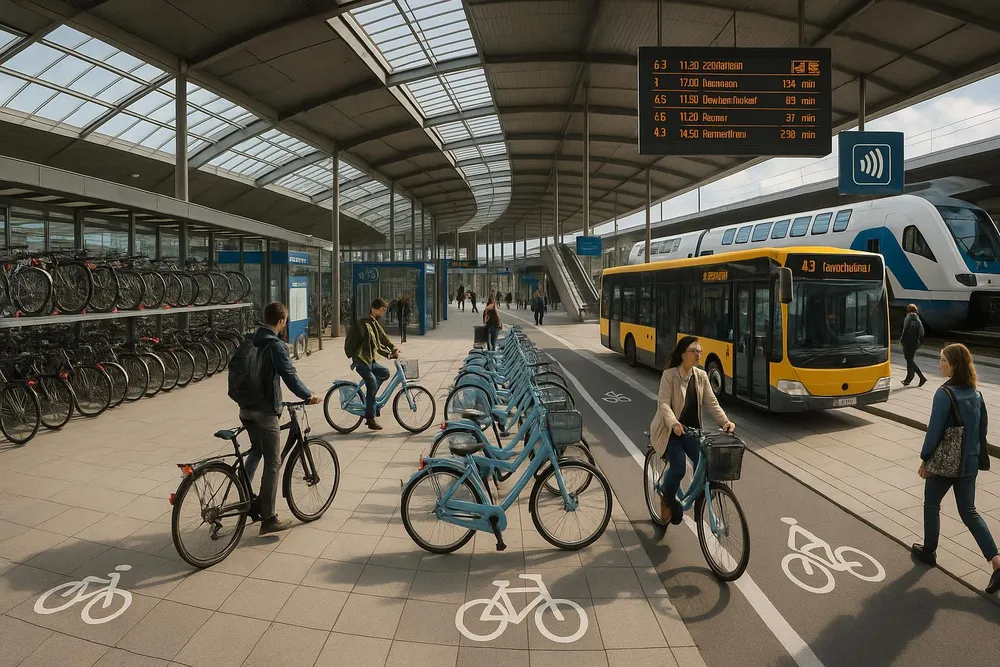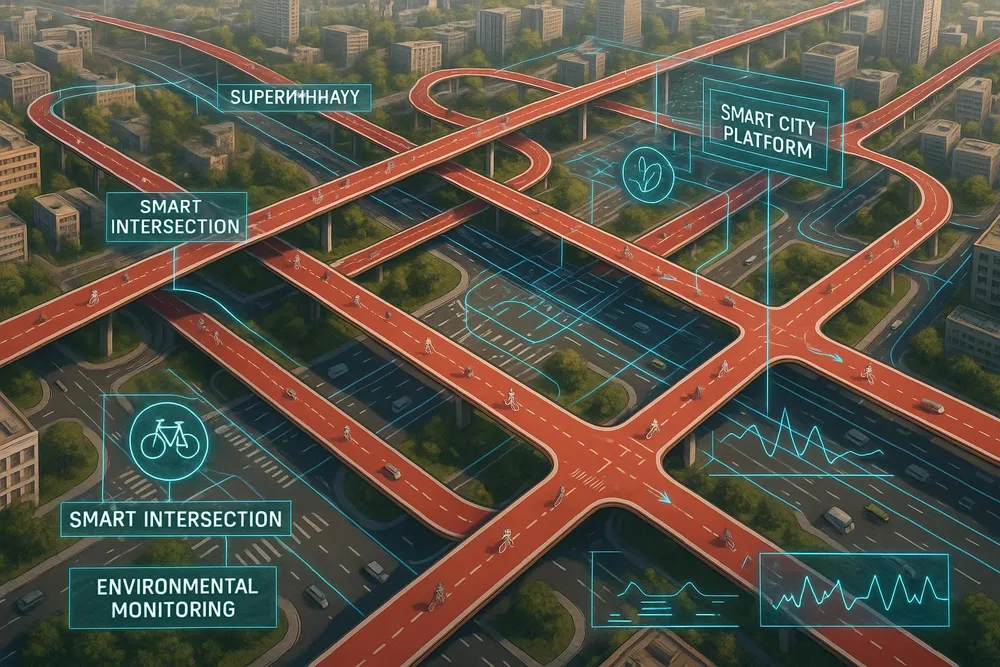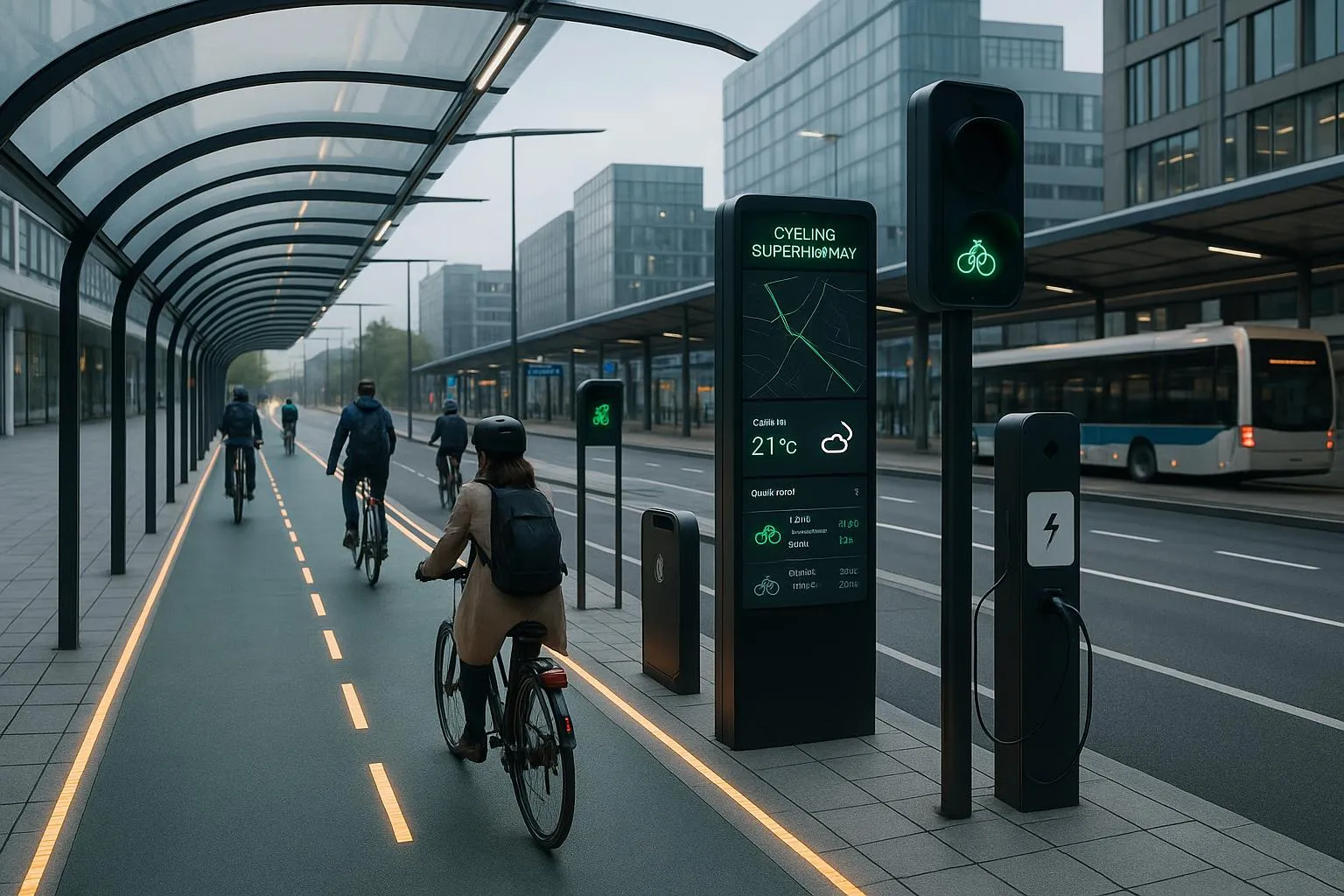The urban cycling landscape is undergoing a profound transformation in 2025, driven by unprecedented government investments, smart city technologies, and a fundamental shift in how cities approach sustainable transportation. From Amsterdam’s advanced bike lane networks to New York’s expanding cycling infrastructure, cities worldwide are reimagining their transportation systems to prioritize cycling as a cornerstone of urban mobility. This revolution extends far beyond simply adding more bike lanes; it encompasses the integration of intelligent infrastructure, the rise of cargo bikes for urban logistics, and the development of comprehensive cycling ecosystems that seamlessly connect with other transportation modes.
The convergence of smart city technologies with cycling infrastructure has created opportunities for innovations that were unimaginable just a few years ago. Intelligent traffic management systems now prioritize cyclist safety and efficiency, while connected infrastructure provides real-time information about route conditions, traffic patterns, and optimal cycling paths. The result is a cycling experience that is safer, more efficient, and more appealing to a broader range of urban residents.
This infrastructure revolution is not merely about accommodating existing cyclists; it represents a strategic approach to addressing some of the most pressing challenges facing modern cities, including traffic congestion, air pollution, public health, and climate change. By creating comprehensive cycling ecosystems that integrate with smart city technologies, urban planners are developing sustainable transportation solutions that can scale to meet the needs of growing urban populations while improving quality of life for all residents.
Government Investment and Policy Transformation
The scale of government investment in cycling infrastructure has reached unprecedented levels in 2025, reflecting a fundamental shift in how policymakers view cycling’s role in urban transportation systems. European cities continue to lead this transformation, with countries like the Netherlands, Denmark, and Germany allocating billions of euros to expand and modernize their cycling infrastructure networks. These investments go far beyond traditional bike lane construction to encompass comprehensive transportation system redesigns that prioritize cycling as a primary mode of urban mobility.
The Netherlands has announced a €2.5 billion cycling infrastructure investment program that will create over 1,000 kilometers of new protected cycling paths by 2027. This ambitious program includes the development of cycling superhighways that connect major urban centers, enabling long-distance commuting by bicycle with the same efficiency and safety as automotive highways. These superhighways feature advanced surface materials that reduce rolling resistance, integrated lighting systems for 24-hour visibility, and weather protection structures that make cycling practical in all conditions.
Germany’s cycling infrastructure investment strategy focuses on integrating cycling networks with public transportation systems, creating seamless multimodal transportation options that make car ownership unnecessary for many urban residents. The program includes the construction of secure bike parking facilities at transit stations, bike-sharing integration with public transportation passes, and real-time information systems that help commuters optimize their multimodal journeys. This integrated approach recognizes that cycling infrastructure must work in harmony with other transportation modes to maximize its effectiveness.
In the United States, the Infrastructure Investment and Jobs Act has allocated $1.2 billion specifically for cycling and pedestrian infrastructure improvements, representing the largest federal investment in cycling infrastructure in American history. This funding is being used to create protected bike lane networks in major cities, improve intersection safety for cyclists, and develop comprehensive cycling networks that connect residential areas with employment centers and commercial districts.
The policy transformation extends beyond infrastructure investment to include comprehensive regulatory changes that prioritize cyclist safety and accessibility. Many cities have implemented Vision Zero policies that aim to eliminate traffic fatalities and serious injuries, with specific focus on protecting vulnerable road users including cyclists and pedestrians. These policies include reduced speed limits in urban areas, enhanced penalties for drivers who endanger cyclists, and mandatory cyclist safety training for commercial drivers.
Urban planning regulations are being updated to require cycling infrastructure in all new development projects, ensuring that cycling considerations are integrated into the urban fabric from the earliest planning stages. These requirements include minimum bike parking ratios for residential and commercial buildings, protected cycling access to all major destinations, and integration with existing cycling networks. The result is a comprehensive approach to urban development that treats cycling infrastructure as essential rather than optional.

Smart Traffic Management and Cyclist Priority Systems
The integration of smart traffic management systems with cycling infrastructure represents one of the most significant technological advances in urban transportation. These systems utilize advanced sensors, artificial intelligence, and real-time data analysis to optimize traffic flow while prioritizing cyclist safety and efficiency. The result is a transportation network that actively supports cycling as a primary mode of urban mobility.
Intelligent traffic signal systems now incorporate cyclist detection technology that can identify approaching bicycles and adjust signal timing to provide safe crossing opportunities. These systems use a combination of video analytics, pressure sensors, and thermal imaging to detect cyclists even in challenging weather conditions or low-light situations. When cyclists are detected approaching an intersection, the system can extend green lights or provide early green signals to ensure safe passage.
The implementation of cyclist priority corridors in major cities has created dedicated traffic management zones where cycling traffic receives priority over automotive traffic. These corridors feature synchronized traffic signals that create “green waves” for cyclists traveling at typical cycling speeds, allowing for uninterrupted travel along major commuting routes. The system continuously monitors cycling traffic patterns and adjusts signal timing to optimize flow for the highest number of cyclists.
Real-time traffic management systems provide cyclists with dynamic routing information based on current traffic conditions, construction activities, and weather patterns. Mobile applications integrated with city traffic management systems can suggest optimal routes that avoid congested areas, construction zones, or adverse weather conditions. This information is also displayed on digital signage along major cycling routes, providing real-time updates to cyclists without requiring smartphone access.
Advanced intersection management systems have been developed specifically to address the complex safety challenges at urban intersections where cyclists interact with automotive traffic. These systems use predictive analytics to identify potential conflict situations and automatically adjust traffic signals to prevent dangerous interactions. When the system detects a potential collision scenario, it can hold conflicting traffic movements until the cyclist has safely cleared the intersection.
The integration of emergency response systems with cycling infrastructure enables rapid response to accidents or medical emergencies involving cyclists. Automated incident detection systems can identify when a cyclist has fallen or stopped unexpectedly, automatically alerting emergency services and providing precise location information. This rapid response capability significantly improves outcomes for cyclists who experience accidents or medical emergencies while riding.
The Cargo Bike Revolution in Urban Logistics
The rise of cargo bikes represents one of the most significant trends in urban transportation, fundamentally changing how goods are delivered and transported within city centers. These versatile vehicles are replacing delivery trucks for last-mile logistics, reducing traffic congestion and emissions while providing more efficient delivery solutions for urban environments. The cargo bike revolution extends beyond commercial applications to include family transportation, with many urban families choosing cargo bikes as car replacements for daily transportation needs.
Commercial cargo bike adoption has accelerated dramatically in 2025, with major logistics companies including UPS, DHL, and Amazon investing heavily in cargo bike fleets for urban deliveries. These companies have found that cargo bikes can navigate congested urban areas more efficiently than delivery trucks, while also providing access to pedestrian zones and areas with vehicle restrictions. The operational cost advantages of cargo bikes, including reduced fuel costs, lower maintenance requirements, and minimal parking fees, make them increasingly attractive for urban logistics operations.
The development of electric cargo bikes has expanded the practical applications of these vehicles, enabling them to carry heavier loads over longer distances while maintaining the efficiency advantages of bicycle transportation. Modern electric cargo bikes can carry loads exceeding 200 kilograms while providing electric assistance that makes them practical for riders of varying fitness levels. Advanced battery systems provide ranges exceeding 100 kilometers, making cargo bikes viable for comprehensive urban delivery networks.
Family cargo bikes have become increasingly popular as urban families seek alternatives to car ownership for daily transportation needs. These bikes can safely transport multiple children along with groceries, school supplies, and other daily necessities, providing a practical and sustainable alternative to automotive transportation. The integration of safety features including seat belts, weather protection, and stability systems makes cargo bikes a safe and comfortable option for family transportation.
The infrastructure requirements for cargo bikes differ significantly from traditional cycling infrastructure, requiring wider lanes, larger turning radii, and specialized parking facilities. Cities are adapting their cycling infrastructure to accommodate these larger vehicles, including the development of cargo bike lanes that provide adequate space for safe operation. Specialized parking facilities for cargo bikes include secure storage areas with charging capabilities for electric models and weather protection for valuable cargo.
Urban planning policies are being updated to support cargo bike adoption through incentives and regulatory changes that favor sustainable transportation options. Many cities now offer subsidies for cargo bike purchases, particularly for families and small businesses that can demonstrate car replacement potential. Zoning regulations are being modified to require cargo bike parking in new commercial developments and to allow cargo bike access to areas traditionally restricted to pedestrians.
Integrated Multimodal Transportation Networks
The development of integrated multimodal transportation networks represents a fundamental shift toward comprehensive urban mobility systems that seamlessly connect cycling with other transportation modes. These networks recognize that most urban trips involve multiple transportation modes and that cycling infrastructure must be designed to facilitate easy transitions between bicycles, public transportation, and other mobility options.
Bike-and-ride facilities at public transportation stations have evolved far beyond simple bike racks to include comprehensive cycling support services. Modern facilities feature secure bike parking with individual lockers, bike maintenance stations with tools and air pumps, and bike-sharing integration that allows commuters to access bicycles at their destination stations. These facilities often include weather protection, lighting, and security monitoring to ensure that cyclists feel safe leaving their bikes for extended periods.
The integration of bike-sharing systems with public transportation passes creates seamless payment and access systems that encourage multimodal transportation use. Commuters can use a single card or mobile app to access buses, trains, and shared bicycles, with integrated pricing that makes multimodal trips more affordable than single-mode alternatives. Real-time information systems provide updates on bike availability, public transportation schedules, and optimal routing for multimodal journeys.
Smart city platforms are being developed that provide comprehensive transportation planning tools for urban residents. These platforms integrate real-time information from all transportation modes, including cycling infrastructure, public transportation, ride-sharing services, and walking routes. Users can plan complex multimodal journeys that optimize for time, cost, environmental impact, or physical activity, with dynamic updates based on current conditions.
The development of mobility hubs at strategic locations throughout cities provides centralized access to multiple transportation modes. These hubs typically include bike-sharing stations, electric scooter parking, public transportation access, and ride-sharing pickup points, all integrated with real-time information systems and unified payment platforms. The strategic placement of mobility hubs ensures that residents have convenient access to sustainable transportation options regardless of their location within the city.
Employer-sponsored transportation programs are increasingly incorporating cycling infrastructure and incentives as part of comprehensive employee mobility benefits. These programs include secure bike parking at workplaces, shower and changing facilities, bike maintenance services, and financial incentives for employees who choose cycling for their commutes. The integration of these programs with public transportation benefits creates comprehensive mobility packages that reduce employee dependence on private vehicle ownership.

Technology Integration and Smart Infrastructure
The integration of advanced technology into cycling infrastructure has created intelligent systems that enhance safety, efficiency, and user experience for urban cyclists. These technological advances go far beyond simple traffic management to include comprehensive monitoring, communication, and optimization systems that make cycling infrastructure more responsive to user needs and changing conditions.
Environmental monitoring systems integrated into cycling infrastructure provide real-time information about air quality, weather conditions, and route safety. These systems use networks of sensors along cycling routes to monitor factors including air pollution levels, temperature, humidity, wind conditions, and precipitation. This information is made available to cyclists through mobile applications and digital signage, enabling informed decisions about route selection and timing.
Intelligent lighting systems along cycling routes automatically adjust brightness and coverage based on usage patterns, weather conditions, and time of day. These systems use motion sensors to detect approaching cyclists and provide enhanced illumination as needed, while dimming lights in unused areas to conserve energy. Advanced systems can also adjust lighting color temperature to improve visibility and reduce light pollution in residential areas.
Predictive maintenance systems for cycling infrastructure use sensor networks and data analytics to identify maintenance needs before problems become apparent to users. These systems monitor factors including surface conditions, drainage effectiveness, lighting functionality, and structural integrity of cycling infrastructure. Predictive algorithms can identify patterns that indicate impending maintenance needs, enabling proactive repairs that minimize disruption to cyclists.
Communication systems integrated into cycling infrastructure provide real-time information about route conditions, traffic patterns, and safety alerts. Digital signage along major cycling routes displays current information about construction activities, weather warnings, and optimal routing suggestions. These systems can also provide emergency communication capabilities, allowing cyclists to quickly contact emergency services or report infrastructure problems.
The integration of cycling infrastructure with smart city platforms enables comprehensive data collection and analysis that supports evidence-based planning and optimization. Anonymized data about cycling patterns, route preferences, and infrastructure usage provides valuable insights for urban planners and transportation authorities. This data-driven approach enables continuous improvement of cycling infrastructure based on actual usage patterns and user needs.
Safety Innovations and Accident Prevention
Advanced safety technologies integrated into urban cycling infrastructure represent a significant leap forward in protecting cyclists and reducing accident rates. These innovations combine physical infrastructure improvements with intelligent monitoring and response systems that actively work to prevent accidents and minimize the severity of incidents that do occur.
Automated conflict detection systems at intersections use advanced video analytics and machine learning to identify potential collision scenarios between cyclists and other road users. These systems can detect when a cyclist and vehicle are on a collision course and automatically trigger warning signals for both parties. In some implementations, these systems can also automatically adjust traffic signals to prevent dangerous interactions from occurring.
Physical separation technologies have evolved beyond traditional barriers to include dynamic separation systems that can adapt to changing traffic conditions. These systems use retractable barriers, adjustable lane markings, and variable message signs to create protected cycling spaces during peak cycling hours while allowing flexible use of road space during other times. The result is more efficient use of limited urban road space while maintaining cyclist safety.
Intelligent surface technologies embedded in cycling infrastructure can detect when cyclists have fallen or stopped unexpectedly, automatically alerting emergency services and providing precise location information. These systems use pressure sensors, accelerometers, and other monitoring technologies to distinguish between normal cycling activities and potential emergency situations. The rapid response capability significantly improves outcomes for cyclists who experience accidents or medical emergencies.
Weather-responsive infrastructure systems automatically adjust to changing conditions to maintain safe cycling conditions. These systems include heated cycling paths that prevent ice formation, drainage systems that quickly clear water from cycling surfaces, and wind barriers that deploy automatically during high wind conditions. The goal is to maintain safe cycling conditions year-round, encouraging continued cycling even during challenging weather.
Enhanced visibility systems use advanced lighting and reflective technologies to improve cyclist visibility to other road users. These systems include embedded LED lighting in cycling paths, dynamic warning signs that activate when cyclists are present, and reflective materials that enhance visibility in low-light conditions. The integration of these technologies creates a comprehensive visibility enhancement system that significantly reduces the risk of accidents due to poor visibility.
Economic Impact and Urban Development
The economic impact of cycling infrastructure investment extends far beyond the direct costs of construction and maintenance to include significant benefits for urban economic development, property values, and business activity. Cities that have invested heavily in cycling infrastructure are experiencing measurable economic returns that justify continued investment and expansion of these systems.
Property value studies consistently show that proximity to high-quality cycling infrastructure increases residential and commercial property values. A comprehensive analysis of property values in cities with extensive cycling networks found average increases of 8-15% for properties within 500 meters of protected cycling infrastructure. This property value premium reflects the desirability of locations with convenient access to sustainable transportation options and the improved quality of life associated with cycling-friendly neighborhoods.
Business district revitalization has been observed in areas where cycling infrastructure improvements have been implemented. Retail businesses along cycling routes report increased foot traffic and sales, as cyclists are more likely to stop and shop compared to drivers who may have difficulty finding parking. The creation of cycling-friendly commercial districts has become a strategy for urban economic development, attracting businesses and customers who value sustainable transportation options.
Tourism benefits from cycling infrastructure are becoming increasingly significant as cities market themselves as cycling destinations. Cities with comprehensive cycling networks attract cycling tourists who contribute to local economies through accommodation, dining, and retail spending. The development of cycling tourism infrastructure, including bike rental facilities, guided tour services, and cycling-friendly accommodations, has created new economic opportunities in many urban areas.
Employment opportunities in the cycling industry have expanded significantly as cities invest in cycling infrastructure and services. These opportunities include infrastructure construction and maintenance, bike-sharing system operation, cycling education and training services, and retail sales of cycling equipment and accessories. The growth of the cycling economy has created sustainable employment opportunities that support urban economic development goals.
Cost-benefit analyses of cycling infrastructure investments consistently show positive returns when all economic impacts are considered. While the initial investment in cycling infrastructure can be substantial, the long-term benefits including reduced healthcare costs, decreased traffic congestion, improved air quality, and increased economic activity typically exceed the investment costs within 10-15 years. These positive economic returns provide strong justification for continued investment in cycling infrastructure.
Future Developments and Emerging Trends
The future of urban cycling infrastructure promises even more sophisticated integration of technology, sustainability, and user-centered design. Emerging trends indicate that cycling infrastructure will become increasingly intelligent, adaptive, and integrated with broader urban systems, creating comprehensive mobility ecosystems that support sustainable urban development.
Autonomous vehicle integration with cycling infrastructure represents an emerging area of development that will require careful planning and coordination. As autonomous vehicles become more prevalent in urban areas, cycling infrastructure must be designed to ensure safe interaction between automated vehicles and cyclists. This includes the development of communication protocols that allow autonomous vehicles to detect and respond appropriately to cyclists, as well as infrastructure design that clearly delineates cycling spaces from automated vehicle corridors.
Climate adaptation strategies for cycling infrastructure are becoming increasingly important as cities prepare for the impacts of climate change. This includes the development of infrastructure that can withstand extreme weather events, flooding, and temperature variations while maintaining safe cycling conditions. Advanced materials and design techniques are being developed to create resilient cycling infrastructure that can adapt to changing environmental conditions.
Energy generation integration with cycling infrastructure offers opportunities to create self-sustaining transportation systems. Solar panels integrated into cycling path covers, wind turbines along cycling corridors, and kinetic energy harvesting from cycling traffic can generate renewable energy that powers lighting, communication systems, and other infrastructure needs. These energy generation systems can make cycling infrastructure carbon-neutral or even carbon-negative over their operational lifetime.
The expansion of cycling infrastructure to suburban and rural areas represents a significant opportunity to extend the benefits of cycling beyond urban centers. This includes the development of cycling networks that connect urban areas with surrounding communities, creating regional cycling systems that support longer-distance cycling for commuting and recreation. The integration of electric bike technology makes longer-distance cycling more practical, expanding the potential reach of cycling infrastructure networks.
International cooperation and knowledge sharing are accelerating the development and implementation of best practices in cycling infrastructure design and management. Cities worldwide are collaborating to share successful strategies, innovative technologies, and lessons learned from cycling infrastructure projects. This global knowledge sharing is accelerating the pace of innovation and helping cities avoid common pitfalls in cycling infrastructure development.
For more information on related cycling technology and infrastructure topics, explore our comprehensive coverage of Smart Cycling Technology Revolution, Cycling Recovery Technology Revolution, and Sustainable Cycling Manufacturing Revolution. Additionally, learn about Bike Security Technology Revolution and Cycling Data Analytics and Performance AI Revolution to understand the broader technological transformation occurring in the cycling industry.




